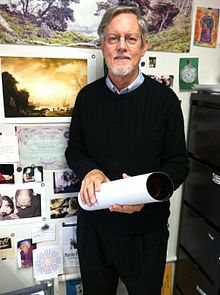Paul K. Hansma
Paul K. Hansma | |
|---|---|
 Hansma in his office (2012) | |
| Born | April 28, 1946 |
| Nationality | American |
| Education | New College, Sarasota, Fl. Bachelor’s (1967) University of California, Berkeley Ph.D., Physics (1972) |
| Alma mater | University of California, Berkeley |
| Occupation | Physicist |
| Known for | Atomic Force Microscope |
| Website | Hansma Lab Website |
Paul K. Hansma is an American physicist at the University of California, Santa Barbara.[1]
Early life and education
Paul K. Hansma was born in Salt Lake City, Utah on April 28, 1946.[2] He received his undergraduate degree from New College of Florida, and his PhD in physics from the University of California, Berkeley where he studied electron tunneling and Josephson junctions.[3]
Career
Hansma became an assistant professor at the University of California, Santa Barbara in 1974. He then became an associate professor three years later.[4] In the 1970s, Hansma began working in electron tunneling spectroscopy, and moved to STM-based experiments by the early 1980s.[5] This included biological STM as of 1985, when he adapted his STM microscopes to work in water (previously STMs would only work in air).[6]
Over the 1980s, Hansma worked in conjunction with IBM Zurich, researching the use of probe microscopy and its use in a variety of different fields.[7] As a part of this work, he co-developed three scanning tunneling microscopes for the University of California, Santa Barbara.[8] In the late 1980s,[9] Hansma then worked on the development of atomic force microscopes and their use in research.[10] This included the use of AFMs in genetic research, using them to observe DNA and RNA molecules in manner that did not disturb their natural interactions during the late 1990s.[11]
In 1991, Hansma researched the process of corrosion in infrastructure and other places like car batteries, and looked at the role the type of electrolyte involved has on the corrosion’s progress.[12] In 2005 Hansma’s discovered the existence of a biopolymer in human bones that provides a “glue” like function, correlatively strengthening or weakening the bone.[13][14] Around this time he also began to develop high-speed scanning AFMs.[15] During his research into bone glue, Hansma developed the OsteoProbe,[16][17] and also spent time researching the use of natural adhesives to create optimized adhesives for other applications.[18] He is also the developer of Reference Point Indentation, which tests bone quality.[19][20] He is also the inventor of Scanning Ion Conductance Microscopy.[21]
Recognition
Hansma is the namesake of the Paul Hansma Research Group at the Department of Physics of the University of California, Santa Barbara.[22] In 1964 he was named a Presidential Scholar by President Lyndon Johnson.[23] He is a fellow of the American Physical Society and the American Association for the Advancement of Science, and was the 2000 recipient of the Max Delbruck Prize in Biological Physics.[3]
References
- ^ "Hansma Research Group – Department of Physics, UC Santa Barbara".
- ^ "Paul K. Hansma | Science History Institute | Center for Oral History".
- ^ a b "Recipient".
- ^ Kenney, Martin; Mowery, David C. (2014-06-18). Public Universities and Regional Growth: Insights from the University of California. ISBN 9780804791427.
- ^ Stoner, Jill (2012-03-09). Toward a Minor Architecture. ISBN 9780262300285.
- ^ Stoner, Jill (2012-03-09). Toward a Minor Architecture. ISBN 9780262300285.
- ^ Stoner, Jill (2012-03-09). Toward a Minor Architecture. ISBN 9780262300285.
- ^ Toumey, Chris P. (2019-01-07). Nanotech and the Humanities: An Anthropologist Observes the Science of Atoms and Molecules. ISBN 9781527524255.
- ^ "Science: Microscope reveals molecules at work".
- ^ Atomic Force Microscopy in Cell Biology. 2002-05-30. ISBN 9780080549446.
- ^ "DNA Cliffhanger". 1997-03-19.
- ^ "Popular Science". Bonnier Corporation. May 1991.
- ^ "C&EN: Latest News - Biopolymer Gives Strength to Bones".
- ^ "Findings, March 2006".
- ^ Morita, Seizo (2006-12-30). Roadmap of Scanning Probe Microscopy. Bibcode:2006rspm.book.....M. ISBN 9783540343158.
- ^ Diez-Perez, A.; Bouxsein, M.L.; Eriksen, E.F.; Khosla, S.; Nyman, J.S.; Papapoulos, S.; Tang, S.Y. (December 2016). "Technical note: Recommendations for a standard procedure to assess cortical bone at the tissue-level in vivo using impact microindentation". Bone Reports. 5: 181–185. doi:10.1016/j.bonr.2016.07.004. PMC 5152622. PMID 27975078.
- ^ "Measuring Bone Strength at University of California Santa Barbara". 2014-09-18.
- ^ "Nature's frugal glues provide insight for optimized adhesives".
- ^ "BizHawk: Medicine Shoppe Pharmacy Closes After Two Decades Downtown". 12 December 2013.
- ^ "UCSB Prof Validates New Bone-Quality Testing Tool". 2010-08-09.
- ^ Kim, Joonhui; Kim, Seong-Oh; Cho, Nam-Joon (February 2015). "Alternative configuration scheme for signal amplification with scanning ion conductance microscopy". Review of Scientific Instruments. 86 (2): 023706. Bibcode:2015RScI...86b3706K. doi:10.1063/1.4907360. hdl:10356/107021. PMID 25725851.
- ^ "Technology Spurs Expansion of AFM Scanning Range". 2013-06-27.
- ^ "Scottsdale Progress Newspaper Archives, Jun 3, 1964". 1964-06-03.
